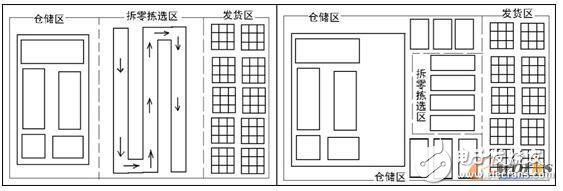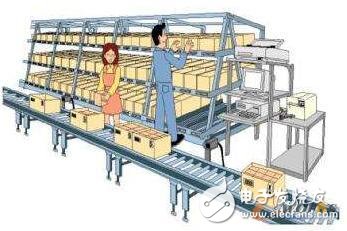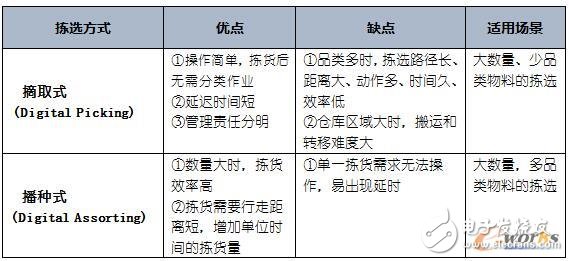I think of the picking of goods. The first thing that most people flash is the busy scene of an e-commerce warehouse or a large supermarket. Take Alibaba's offline supermarket, Box Horse Fresh, as an example. The delivery speed is one of the important selling points. It is required to deliver the goods to the door within 30 kilometers of the store. Then, the requirements for picking will undoubtedly require high standards. In fact, in manufacturing companies, picking demand is also critical, and more and more companies are beginning to pay attention to the efficiency of warehouse management and distribution.
The first thing to understand is what is the form of picking? From the point of view of manual picking, picking is usually divided into Digital Picking and Seeding (Digital AssorTIng).

Figure 1 Typical layout of picking methods (manual picking picking VS manual picking picking)
Picking picking refers to the process of picking and concentrating the goods one by one according to the goods information on the order to the corresponding storage location by the picker for each order. To put it simply, the warehouse staff picks up and returns the materials needed for the order to and from each shelf position according to an order. This method is widely used in many manufacturing enterprises. Its biggest advantage is that it does not need to carry out any “secondary processing†according to the picking list, and it does not require too many skill requirements for warehouse managers. The timeliness of material acquisition can be guaranteed for a single order. However, as a traditional method of picking goods, the picking process of small orders and large quantities of orders can be supported. Once the variety of goods is large, the process of picking up will have repeated paths, too long, etc. Efficient situations arise, and handling can become difficult if the warehouse space has a large span of picking areas.

Figure 2 Typical picking picking scene
Seeding picking refers to the collection of multiple orders in a certain period of time into one batch, and the quantity of goods is summarized according to the type of goods. The warehouse personnel selects the goods according to the goods, and then corresponds to each collar by way of the goods. Bill of materials. The biggest advantage of the seeding type is that when the quantity of the material to be sorted is large, the "merging" method can be used to improve the efficiency, shorten the carrying distance, and increase the number of picking per unit time. Manufacturing companies that use sowing picks usually have a large variety of orders and quantities. However, the most significant disadvantage of this method is that the skill requirements of the warehouse personnel are relatively high. The summary of the orders requires time and skill, the operation is relatively complicated, and the probability of corresponding manual operations is relatively high. In addition, for a single picking list, it is very likely that some materials are delayed due to the small number of picking.

Figure 3 Typical seeding picking scene
In order to improve the efficiency of picking, to avoid problems such as mistakes and leaks affecting production, we will also use compound picking methods to foster strengths and avoid weaknesses. For example, "sowing + picking", this method adheres to the method of summarizing the demand for picking, and then takes out all the required materials and places them in the sorting area, and then picks the picking sheets according to actual needs. Picking is done sequentially. This combines some of the advantages of the two original sorting methods, and is often used in situations where the variety is small and the demand for multiple picking is required. Another common compound picking method is “seeding + seedingâ€, which is relatively complicated and often used in the case of multiple varieties and multiple picking needs.

Contrast picture of two common picking methods
Although enterprises are paying more and more attention to warehousing management, most SMEs still adopt the traditional method of picking goods. On the one hand, the tolerance of warehouse personnel is relatively high, on the other hand, the faulty haircuts affect the production schedule and even stop work. Events are also commonplace. Conditional enterprises can adopt advanced technology equipment and software systems such as three-dimensional warehouse, robot, WMS, DPS, etc., to quickly improve the picking efficiency of manufacturing enterprises and improve the logistics level. The developing SMEs need to select the appropriate single or composite sorting method according to the material weight, production method, order quantity, product variety and other comprehensive factors of the product materials, and cooperate with the design of the warehouse path and the improvement of the warehouse personnel skills. Warehouse management level, the largest level of production services.
2.1 Home Theater Speaker,2.1 Speaker System Home Theater,Surround Sound Speakers,2.1 Home Theater
GUANGZHOU SOWANGNY ELECTRONIC CO.,LTD , https://www.jerry-power.com
![<?echo $_SERVER['SERVER_NAME'];?>](/template/twentyseventeen/skin/images/header.jpg)